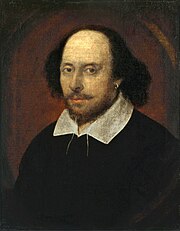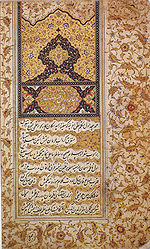Portal:Poetry/Selected article archive/2006 archive
This is an archive of article summaries that have appeared in the Selected article section of Portal:Poetry in 2006. For past archives, see the complete archive page.

Imagism was a movement in early 20th century Anglo-American poetry that favoured precision of imagery, and clear, sharp language. The Imagists rejected the sentiment and artifice typical of much Romantic and Victorian poetry. This was in contrast to their contemporaries, the Georgian poets, who were by and large content to work within that tradition. Group publication of work under the Imagist name in magazines and in four anthologies appearing between 1914 and 1917 featured writing by many of the most significant figures in Modernist poetry in English, as well as a number of other Modernist figures who were to be prominent in fields other than poetry.
The history of Irish poetry includes the poetries of two languages, one in Irish and the other in English. The complex interplay between these two traditions, and between both of them and other poetries in English, has produced a body of work that is both rich in variety and difficult to categorise.
The earliest surviving poems in Irish date back to the 6th century and the first known poems in English from Ireland date from the 14th century. Although some cross-fertilization between the two language traditions has always happened, the final emergence of an English-language poetry that had absorbed themes and models from Irish did not appear until the 19th century. This culminated in the work of the poets of the Celtic Revival at the end of the 19th and beginning of the 20th century.
 |
| Oil painting of Ben Jonson, after Abraham Blyenberch, circa 1617. |
Benjamin Jonson (circa June 11, 1572 – August 6, 1637) was an English Renaissance dramatist, poet and actor. He is best known for his plays Volpone and The Alchemist, his lyrics, his influence on Jacobean and Caroline poets, his theory of humours, his contentious personality, and his friendship and rivalry with William Shakespeare.
Although he was born in Westminster, London, Jonson claimed his family was of Scottish Border country descent, and this may be confirmed by the fact that his coat of arms bears three spindles or rhombi, a device shared by a Borders family, the Johnstones of Annandale. His father died a month before Ben's birth, and his mother remarried two years later, to a master bricklayer. Jonson attended school in St Martin's Lane, and was later sent to Westminster School, where one of his teachers was William Camden. On leaving, Jonson is said to have gone on to the University of Cambridge.
 |
| Oil painting of Louis XIV of France. |
French literature of the 17th century spans the reigns of Henry IV of France, the Regency of Marie de Medici, Louis XIII of France, the Regency of Anne of Austria (and the civil war called the Fronde) and the reign of Louis XIV of France. The literature of this period (the "Grand siècle") is often equated with the Classicism of Louis XIV's long reign during which France was beyond question the leading country in Europe (both politically and culturally) and the classical ideals of order, clarity, sense of proportion, and good taste were expounded -- but the century produced in fact far more than just the classicist masterpieces of Jean Racine and Madame de Lafayette.
In Renaissance France, literature (in the broadest sense of the term) was largely the product of encyclopedic humanism (works produced by an educated class of writers (both noble and bourgeois) from religious and legal backgrounds), although a new conception of nobility, modeled on the Italian Renaissance courts and their concept of the perfect courtier, began to take hold.
 |
| The Old English epic poem Beowulf is written in alliterative verse. |
In prosody, alliterative verse is a form of verse that uses alliteration as the principal structuring device to unify lines of poetry, as opposed to other devices such as rhyme.
The most intensively studied traditions of alliterative verse are those found in the oldest literature of many Germanic languages. Alliterative verse, in various forms, is found widely in the literary traditions of the early Germanic languages. The Old English epic Beowulf, as well as most other Old English poetry, the Old High German Muspilli, the Old Saxon Heliand, and the Old Norse Poetic Edda all use alliterative verse.
Alliterative verse can be found in many other languages as well, although rarely with the systematic rigor of Germanic forms. The Finnish Kalevala and the Estonian Kalevipoeg both use alliterative forms derived from folk tradition. Traditional Turkic verse, for example that of the Uyghur, is also alliterative.
 |
| The famous Chandos portrait of William Shakespeare. |
William Shakespeare (baptised April 26, 1564 – died April 23, 1616) was an English poet and playwright widely regarded as the greatest writer of the English language, as well as one of the greatest in Western literature, and the world's preeminent dramatist. He wrote about 38 plays and 154 sonnets, as well as a variety of other poems. Already a popular writer in his own lifetime, Shakespeare's reputation became increasingly celebrated after his death and his work adulated by numerous prominent cultural figures through the centuries. In addition, Shakespeare is the most quoted writer in the literature and history of the [[English-speaking world. He is often considered to be England's national poet and is sometimes referred to as the "Bard of Avon" (or simply "The Bard or the "Swan of Avon".

Turkish literature is the collection of written and oral texts composed in the Turkish language, either in its Ottoman form or in less exclusively literary forms, such as that spoken in the Republic of Turkey today. The Ottoman Turkish language, which forms the basis of much of the written corpus, was heavily influenced by Persian and Arabic and used a variant of the Perso-Arabic script.
The history of Turkish literature spans a period of nearly 1,500 years. The oldest extant records of written Turkish are the Orhon inscriptions, found in the Orhon River valley in central Mongolia and dating to the 8th century. Subsequent to this period, between the 9th and 11th centuries, there arose among the nomadic Turkic peoples of Central Asia a tradition of oral epics, such as the Book of Dede Korkut of the Oghuz Turks—ancestors of the modern Turkish people—and the Manas epic of the Kyrgyz people.
Beginning with the Seljuks in the 11th century, the Oghuz Turks began to settle in Anatolia, and in addition to the earlier oral traditions there arose a written literary tradition heavily influenced by Arabic and Persian literature. For the next 900 years, until shortly before the fall of the Ottoman Empire in 1922, the oral and written traditions would remain largely separate from one another. With the founding of the Republic of Turkey in 1923, the two traditions came together for the first time.
